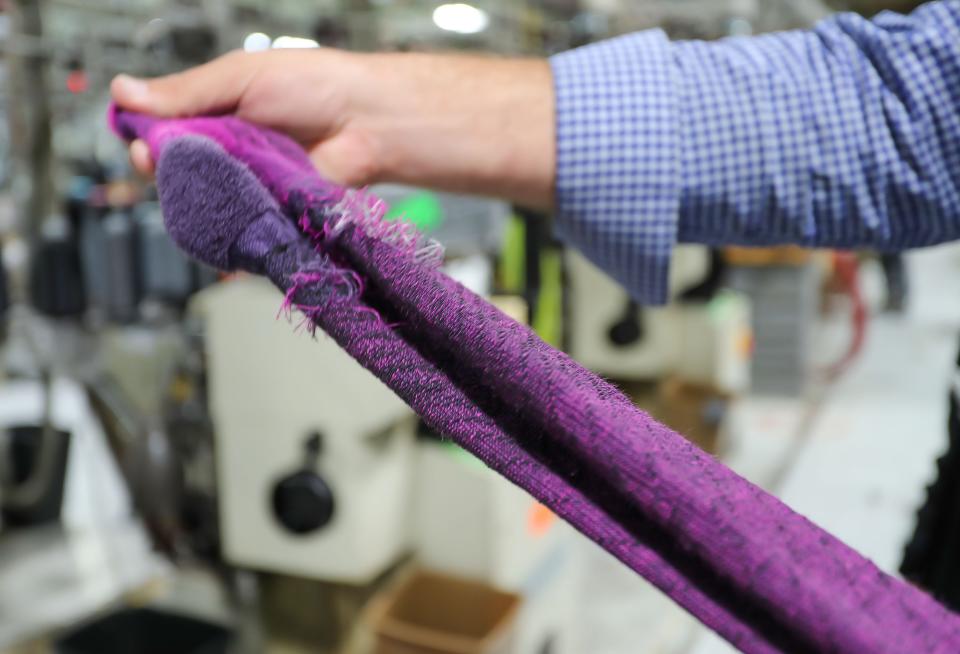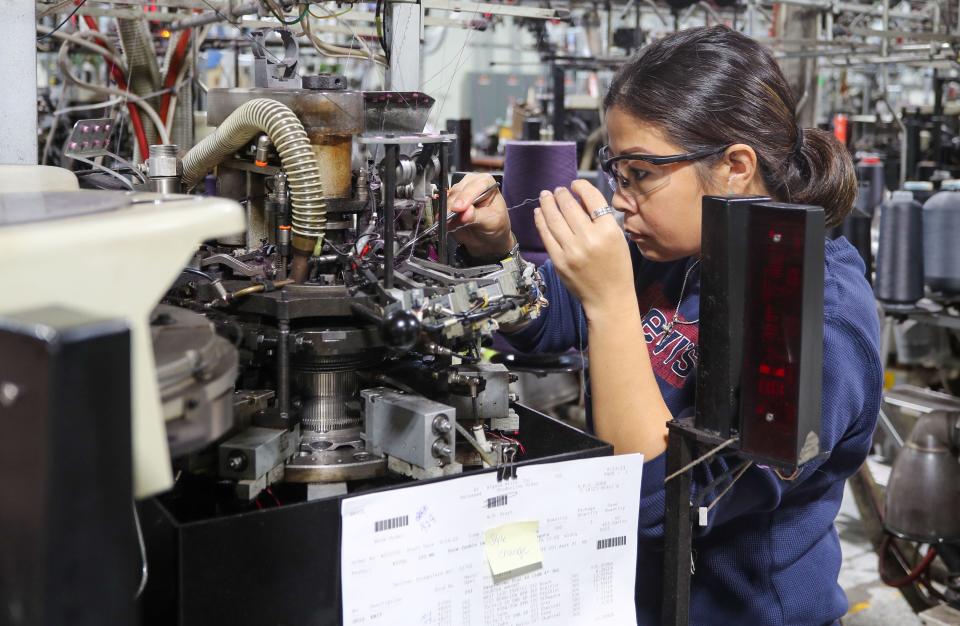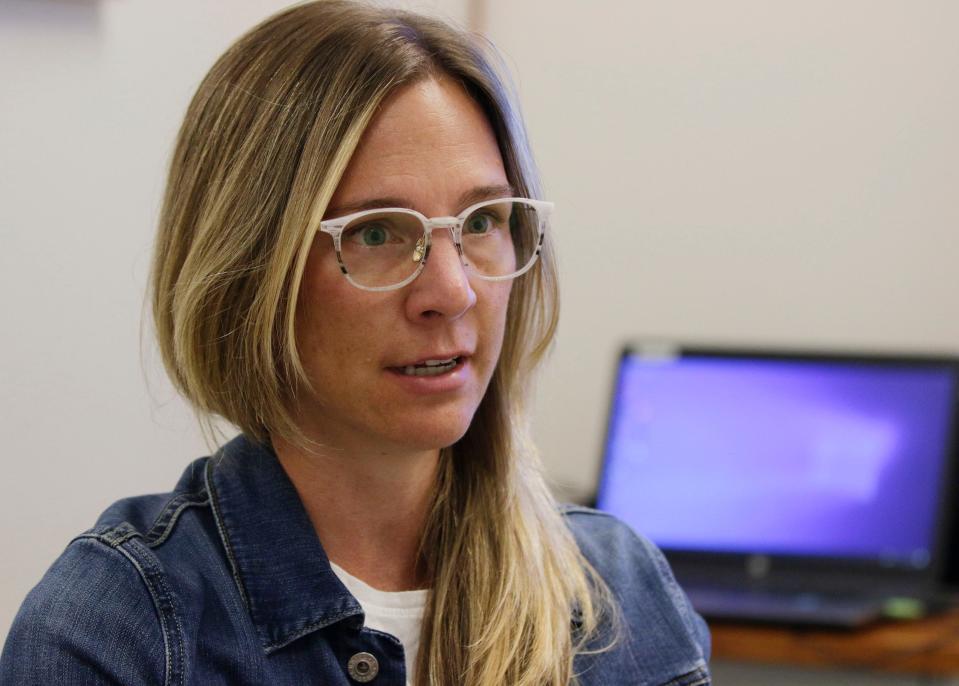Wigwam Mills has made 'filet mignon' quality of socks for more than 100 years. Here's how.
This story is part of a Streetwise series on “How It’s Made” in Sheboygan. The series will help give a behind-the-scenes look at how businesses and crafters across Sheboygan County make the goods you may use or consume every day. Want to know how something is made? Contact Alex Garner at 224-374-2332, agarner@gannett.com or on Twitter at @alexx_garner and we'll find out for you.
SHEBOYGAN — Wigwam Mills is striving toward innovation and "sustainable" growth as it nears 120 years of business in Sheboygan.
The premium sock-maker company, founded in 1905, is in its fourth generation, now led by siblings and co-owners Chris Chesebro and Margaret Newhard.
The company has had countless milestones over its history, like becoming the official sock sponsor of the Ironman Triathlon World Championship in the 1990s and partnering with the U.S. Ski and Snowboard team as its official sock supplier.
It has broadened its product base, too, making socks for the outdoors, military and everyday use. Wigwam has also downsized its production and workforce, opened an outlet store and created new socks in recent years.
The Sheboygan Press toured the Wigwam manufacturing plant, 5300 Highway 42, with Chesebro and Newhard. Here’s what we learned about the sock-making process, workforce plans and innovation.
More How It's Made: Kohler WasteLab is turning manufacturing waste into new sustainable products. Here's how.
Making a ‘filet mignon’ quality of sock
Socks are knit, not woven or sewn, Chesebro said.
Yarn — in different colors, sizes and fiber blends — are knit on Italian Sangiacomo machines on the manufacturing floor. There are about 100 machines, many paired with the expertise of knitting operators and mechanics.
Chesebro said yarn materials are sourced weekly, from domestic suppliers when possible.
The yarn is knit into interconnected loops in a cylinder, essentially creating a tube. One sock can use anywhere from two to 14 yarn strands, Chesebro said.
He said more than 100 needles grab yarn stitches in the cylinder to move them at the right time. Each sock has thousands and thousands of stitches. Even a “slight bend of the needle can affect the quality of the sock and how it performs," he continued.
Knitting operators adjust the needles and yarn fibers when necessary.
“It's not like injection molding because you are using fibers that stretch and move,” Chesebro said. “There is an art to it because you're dealing with things that react to humidity and tension — those types of things.”

Chesebro said mechanics complete an apprenticeship program to understand how the complicated Italian machinery works, which can take four years to finish. Some take classes at Lakeshore Technical College.
“A lot of people ask us, ‘Do you have different machines that are better than everyone else's?’ And I say, ‘No, we have the same machines, but we have better people,” Chesebro said.
Knowledge and experience are shared this way, he said, which can ensure the machines perform better to make better products.
“I always tell people we make filet mignon, not bologna,” he said.
After the socks are made, they’re sent out for laundering, returned, inspected and packaged. Chesebro said Wigwam looks at every sock, unlike other mills who may not have a 100% inspection standard.

Sign up for the Streetwise newsletter Click here to get all the business openings and closings news right in your inbox
A sock can be made in several minutes.
Chesebro said it can take two-and-a-half to eight minutes to make a sock at Wigwam, depending on its complexity and size.
Thousands of pairs of socks are made each day.
Across two shifts, the manufacturing team can make 3,000 to 4,000 pairs of socks a day, according to Chesebro.

The price for a pair of socks ranges.
A pair of socks can range from $10 to about $25, according to Wigwam's online store.
Wigwam socks can last more than a decade, some customers say.
The use and frequency will differ across socks, but Chesebro said they receive messages from customers about theirs lasting more than 10 years.
“These (socks) will perform probably well past the lifetime of the shoe and a lot of your other apparel,” Chesebro said.
Flawed socks are sold at discounted rates or donated.
Socks with defects or flaws that don’t pass the company’s quality standard are sold at a discounted price in the outlet store, according to Chesebro. These include socks with cosmetic issues, like uneven stitches or a mis-knit pattern.
Socks with holes or runs, however, are donated to RCS Empowers, Inc., to support homeless shelters.
More How It's Made: Ampersand is more than just an art supply store. Here's how it makes a home for Sheboygan creators
Wigwam is looking for 'slow, sustainable' growth following mass layoffs in 2020.
Among manufacturing companies experiencing short staffing in the county, Newhard said Wigwam is “lucky.”
“We have a really loyal employee base,” she said. “Our average tenure here is 20 years. And we have some people that are getting to (the) 30- and 40-year mark.”

Wigwam has about 57 employees across the manufacturing plant and office, a significant decrease from earlier years. In 2019, the company had 175 employees and had hopes to grow its workforce by more than 25%, according to the Milwaukee Journal Sentinel.
At the time of a permanent layoff in June 2020, Wigwam had roughly 140 employees. The company laid off about 121 of 142 employees that summer as a result of the “adverse impact” the pandemic had on operations and sales, according to a letter sent to the Wisconsin Department of Workforce Development.
Companies with mass layoffs must give a 60-day advance notice in accordance with state and federal laws, but Wigwam said in the letter the “sudden unexpected and unforeseen adverse circumstances” prevented it from doing so. The letter was dated 11 days before the layoffs went into effect June 1.
At the time, Chesebro told the Sheboygan Press the company would work with lower-seniority union members to search for other local jobs.
Changes at Kohler Energy: Kohler Co. is planning to sell the majority of its energy division. Here's what we know.
Soon after the layoffs, the company received a $1.6 million Paycheck Protection Program loan to retain employees. U.S. Department of Treasury data said the loan helped retain about 145 employees (the company’s end-of year staff for 2019 listed on the application), but the Sheboygan Press was told at the time about 40 people were employed, and the loan helped bring some people back.
Since then, Chesebro said Wigwam has been conscientious about having to scale its labor force and grow in a slow, sustainable way.
“Where we add one at a time versus trying to hire a dozen people and then have a flux in volume,” he said. “We want to make sure that when we hire someone it is for as long as they want to work here.”
The 'SynchroKnit' is a modern design to fit a human foot.
Among its many socks, Wigwam has worked to innovate new varieties and technologies, some targeted at fit, moisture removal and blister prevention.
One of these products is the SynchroKnit sock, customized to fit a human foot.
Newhard said this is accomplished by reducing how much fabric is used to make the sock, whereas a typical sock is knit as a tube and can be fitted by changing tension and stretch materials.

“If you would think of buying a pair of pants off the rack, you'd use a belt to make it fit the way that you'd like it to fit,” Newhard said. “Essentially what SynchroKnit does is it allows you to break outside of that circumference.”
Less fabric in some areas of a SynchroKnit sock can create more compression and a fitted feel.
“You just don't need all that fabric,” she said. “Sometimes you may realize your sock is bunching up in your shoe, it's moving around. It (SynchroKnit) is just a super specific and custom fit for your foot.”
This article originally appeared on Sheboygan Press: Wigwam Mills shows how it makes premium socks at Sheboygan plant
